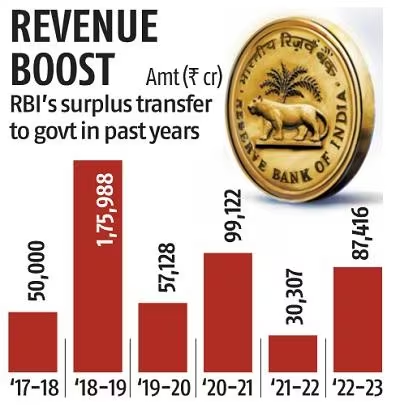Monday, 8th July 2024
India’s Balance of Payments
Why in the news?
- After a gap of 10 quarters, India’s current account balance posted a surplus of $5.7 billion or 0.6% of gross domestic product (GDP) during the fourth quarter (Jan-Mar) 2024 (Q4FY24) mainly due to a surge in services exports.
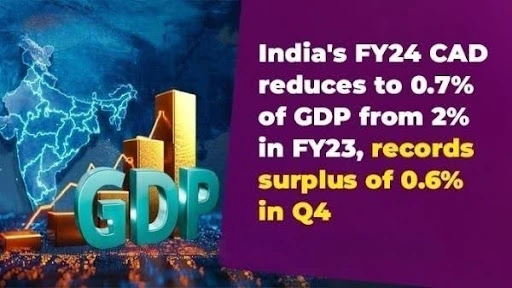
- The country’s current account cannot be understood in isolation, and the larger picture is provided by the so-called ‘Balance of Payments’.
What is Balance of Payments (BoP)?
- Understanding the Meaning of BoP:
- BoP summarises all transactions that a country's individuals, companies, and government bodies complete (over a defined period) with individuals, companies, and government bodies outside the country.
- For example, it shows how much money (in US Dollar or Indian Rupee terms) went out of the country and how much money came into the country.
- These transactions could be:
- Trade (export or import) of goods or services.
- Investments (an Indian buying land in the US or an American firm investing in the Indian stock exchanges).
- Exchange of loans between Indian and other countries of the world, etc.
Constituents of the BoP:
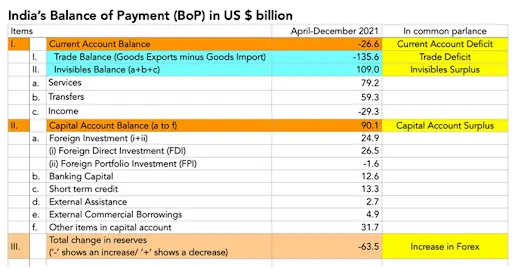
- All possible transactions are divided into two main accounts - the Current Account and the Capital Account.
- Current Account:
- It refers to all transactions that are related to current consumption and is further divided into:
- Trade Balance (the export and import of physical goods).
- Invisibles Trade (trade in services, e.g., banking, IT, tourism, etc).
- As seen from the table, India had a trade deficit (import>export) but a surplus in the Invisibles trade.
- However, since the trade deficit was bigger than the surplus on the Invisibles trade, the overall current account of India is also in negative or deficit. This is called the Current Account Deficit (CAD).
- Capital Account:
- The capital account refers to those transactions which are not for current consumption but for investment.
- It includes net foreign investments (either foreign direct investment or foreign portfolio investments) and loans or money that countries borrow from each other.
- As seen from the table, India had a capital account surplus of $90 billion from April-December 2021 as against a current account deficit of $26.6 billion.
- BOP:
- Individually, either of these accounts can be in surplus or deficit.
- A surplus implies that more money is coming into the country than going out of it, whereas a deficit (shown with a (-) mark) implies more money is going out of the country than coming in.
- By definition, the BoP always balances, which implies that the deficit on one account must be balanced by a surplus on the other account.
How does the BoP Balance?
- The net result of a current account deficit ($26.6 billion) and a capital account surplus ($90.1 billion) is that a total of 63.5 billion US dollars have entered the Indian economy.
- To balance the BoP, RBI takes out these dollars and keeps them with itself (shown with a (-) sign before it) and adds (as assets) to its foreign currency reserves.
- The increased forex also leads to an increased money supply in the Indian economy (which can also lead to higher inflation), as RBI increases its liabilities by the same amount ($63.5 billion) by printing the domestic currency.
- This elucidates RBI’s role in maintaining the BoP, which in turn determines India's exchange rate and foreign exchange reserves.
Why does the RBI Intervene?
- Take a case when more and more dollars have started coming into the Indian economy because of a growing capital account surplus.
- If the RBI does not intervene, the increased demand for rupees vis-a-vis the dollar would have meant that the rupee would have appreciated in value.
- As a result, India’s exports would have become costlier for the US or the rest of the world, thus bringing down their demand.
- At the same time, Indians would have found foreign goods cheaper, thus India’s imports would have gone up.
- This would have led to a widening of the trade deficit or the current account deficit to such an extent that the BoP would have balanced on its own.
- When the RBI intervenes, India's exchange rate remains constant while its forex reserves increase.
How to Read the RBI’s Q4FY24 BoP Figures?
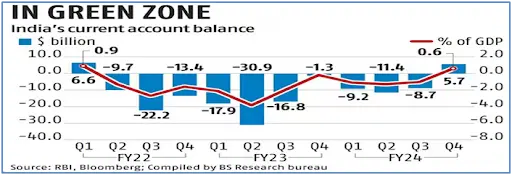
- Apart from a current account surplus of $5.7 billion, the Q4FY24 shows a net surplus of $25 billion on the capital account.
- There was a current account deficit of $1.3 billion (0.2% of GDP) during the fourth quarter, which was $8.7 billion (1% of GDP) during the quarter ended December 2023 (Q3FY24).
- Contrary to the images they evoke, the words ‘deficit’ and ‘surplus’ do not always correlate to ‘bad’ and ‘good’ respectively.
- For example, a surplus on the current account in FY 2020-21 did not lead to much economic activity due to Covid-induced lockdowns.
- Typically, for a country like India, a current account deficit happens because a developing economy needs to import lots of capital goods (say, machineries) to build up its capacity to produce more exports.
- A trade deficit also suggests that India’s underlying economy has a strong demand impulse.
- For a country like India, a current account deficit of 1.5%-2% of GDP is consistent with a GDP growth rate of 7%-8%.
Source: IE
Manufacturing in Defence Hits Record High
Why in the News?
- According to the Defence Ministry, India’s indigenous defence production surged to a record high of Rs 1.27 lakh crore in 2023-24.
- This 16.7% growth compared to the previous fiscal year is credited to government policies and self-reliance initiatives.
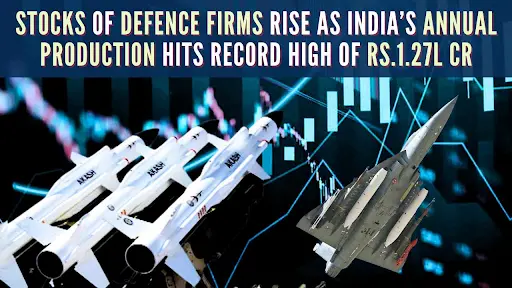
Steps Taken by the Government to Boost Defence Manufacturing:
- Policy Reforms and Strategic Initiatives:
- Defence Procurement Procedure (DPP):
- The DPP has been revised to promote indigenous manufacturing and enhance transparency and efficiency in the procurement process.
- It includes a category called 'Buy (Indian-IDDM)' which prioritises products designed, developed, and manufactured indigenously.
- Defence Production and Export Promotion Policy (DPEPP) 2020:
- This policy aims for a turnover of ₹1.75 lakh crore in aerospace and defence goods and services by 2025, including ₹35,000 crore in exports.
- Strategic Partnership Model:
- This model encourages collaboration between Indian private companies and foreign original equipment manufacturers (OEMs) to set up manufacturing facilities in India, fostering technology transfer and capability building.
- Negative Import List/Positive Indigenisation List:
- Five positive indigenisation lists have been released.
- Items on these lists cannot be imported by the Services and must be sourced domestically.
- Defence Offset Policy:
- This policy requires foreign defence companies to invest a part of their contract value in India, promoting technology transfer and local manufacturing.
- Defence Procurement Procedure (DPP):
- Financial and Structural Support:
- Foreign Direct Investment (FDI):
- The FDI limit in the defence sector has been raised to 74% through the automatic route and up to 100% through government approval in cases involving access to modern technology or other specified reasons.
- Defence Corridors:
- Defence industrial corridors have been established in Uttar Pradesh and Tamil Nadu to create a conducive ecosystem for defence manufacturing.
- These corridors aim to attract investments and generate employment.
- Budget 2023-24:
- The government allocated 75% of its defence capital budget for 2023-24 towards procurements from domestic sources.
- Foreign Direct Investment (FDI):
- Infrastructure and Innovation:
- Innovation for Defence Excellence (iDEX):
- iDEX fosters innovation and technology development in defence and aerospace by engaging startups and MSMEs.
- It provides financial support and a platform for showcasing solutions.
- Technology Development Fund (TDF):
- This fund supports the indigenous development of defence technology and products. It offers grants to MSMEs, startups, and academia for research and development projects.
- Innovation for Defence Excellence (iDEX):
- Public-Private Partnership
- Ordnance Factory Board (OFB) Corporatization:
- The OFB has been restructured into seven new Defense Public Sector Undertakings (DPSUs) to enhance autonomy, efficiency, and accountability.
- Increased Role of Private Sector:
- The government has actively encouraged private sector participation in defence manufacturing by allowing private companies to bid for contracts previously reserved for DPSUs.
- Ordnance Factory Board (OFB) Corporatization:
Defence Manufacturing in FY 2023-24:
- India’s defence production achieved an unprecedented milestone, reaching approximately Rs 1.27 lakh crore in the financial year 2023-24.
- This represents a 16.7 percent increase over the previous year and a significant 60 percent growth since 2019-20.
- In FY 2023-24, Defense Public Sector Undertakings (DPSUs) and other Public Sector Units (PSUs) contributed 79.2% of the total value of production (VoP) in India's defence manufacturing sector, while the private sector accounted for 20.8%.
- Both public and private sectors have shown steady growth in absolute terms.
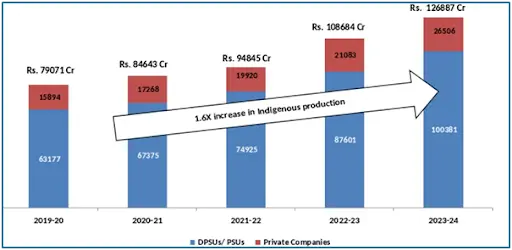
Defence Exports:
- India’s defence exports have also experienced remarkable growth, contributing to the overall rise in indigenous defence production.
- Defence exports reached a record high of Rs 21,083 crore in FY 2023-24, reflecting a 32.5 percent increase over the previous fiscal’s Rs 15,920 crore.
|
UPSC Civil Services Examination, Previous Year Question (PYQ) Prelims Q:1 Which one of the following is the best description of ‘INS Astradharini’, that was in the news recently? (2016)
Ans: (c) Q.2 Consider the following in respect of Indian Ocean Naval Symposium (IONS): (2017)
Which of the above statements is/are correct?
Ans: (b) Q:3 The term ‘IndARC’, sometimes seen in the news, is the name of (UPSC 2015)
Answer: (d) Q: 4 What is "Terminal High Altitude Area Defence (THAAD)", sometimes seen in the news? (UPSC 2018)
Answer: (c) Q:5 Which one of the following is the best description of ‘INS Astradharini’, that was in the news recently? (UPSC 2016)
Answer: (c) Q:1 Foreign Direct Investment (FDI) in the defence sector is now set to be liberalised.What influence is this expected to have on Indian defence and economy in the short and long run? (UPSC 2014) |
Source: IE
Primary Agriculture Credit Societies
Why in the News?
- Union Minister of Home Affairs and Cooperation, Amit Shah, urged stakeholders in cooperative societies to support the establishment of primary agricultural credit societies (PACS) in all villages and blocks of the country.
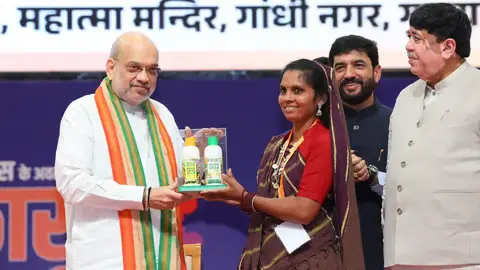
What is a Primary Agricultural Credit Society (PACS)?
- Definition:
- PACS are village-level cooperative credit societies that serve as the last link in a three-tier cooperative credit structure headed by the State Cooperative Banks (SCB) at the state level.
- Credit Structure:
- Credit from the SCBs is transferred to the District Central Cooperative Banks (DCCBs), which operate at the district level.
- The DCCBs work with PACS, which deal directly with farmers.
- Membership and Governance:
- Since these are cooperative bodies, individual farmers are members of the PACS, and office-bearers are elected from within them.
- A village can have multiple PACS.
- Functions:
- PACS provide short-term and medium-term agricultural loans to farmers for various agricultural and farming activities.
Number of PACS in India:
- Historical Background: The first PACS was formed in 1904.
- Current Statistics:
- There are more than 1,00,000 PACS in the country.
- These PACS have a huge member base of more than 13 crore farmers.
- However, only 65,000 of them are functional.
Significance of PACS:
- Last Mile Connectivity:
- PACS provide crucial connectivity to the farmers, ensuring they reach the end beneficiaries efficiently.
- Timely Access to Capital:
- Farmers need prompt access to funds at the beginning of their agricultural activities, which PACS can facilitate.
- Minimal Paperwork:
- PACS are capable of extending credit with minimal paperwork and in a short time frame.
- Comparison with Scheduled Banks:
- Farmers often face tedious paperwork and bureaucratic delays with scheduled commercial banks.
- Collective Strength:
- PACS offer strength in numbers, as the office-bearer of the PACS manages most of the paperwork for the farmers.
- Individual Requirements:
- In scheduled commercial banks, farmers have to individually fulfil requirements and often need agents to get their loans sanctioned.
Challenges Faced by PACS:
- Political Influence:
- Political compulsions can overshadow financial discipline, impacting the recovery of loans.
- Identified Issues:
- Various committees have highlighted issues such as:
- Lack of active participation by members
- Lack of professionalism
- Absence of corporate governance
- Bureaucratisation
- Ageing and unenthusiastic employees
News Summary:
- Government Initiative:
- Union Minister Amit Shah, addressing a program in Gandhinagar for the 102nd International Day of Cooperatives, announced the government's plan to establish PACS in every village and block.
- Current Deficit:
- There are currently 2 lakh gram panchayats without PACS.
- Cooperative Sector Strengthening:
- Shah urged cooperative societies to open bank accounts with local cooperative banks and buy from local dairies to strengthen the cooperative sector.
- Expansion Drive:
- The cooperation ministry aims to establish 2 lakh dairies and PACS in the 2 lakh gram panchayats currently lacking such facilities.
- Database Initiative:
- In March 2024, the government launched the National Cooperative Database, releasing the 'National Cooperative Database 2023: A Report' to identify and address gaps through comprehensive analysis.
- Future Plans:
- The Centre plans to form PACS in every village by 2029.
- A new national cooperative policy is expected within a month to replace the existing 2002 policy, aiming to further strengthen the cooperative movement in the country.
Source: TOI
Karnataka Bill Promise Gig Workers
Why in the News?
- Recently, on June 29, the Karnataka government published the draft of the Karnataka Platform-based Gig Workers (Social Security and Welfare) Bill, making it the second Indian State to initiate such a move, the first being Rajasthan.
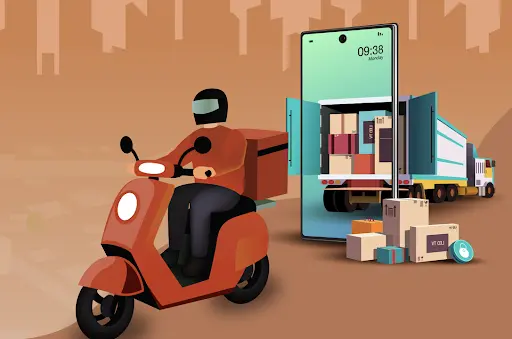
What is the Gig Economy?
- A gig economy is a free market system in which organisations hire or contract workers for a short span of time.
- Simply put, the positions are temporary to meet the company’s requirements by having short-term engagements.
- Startups like Ola, Uber, Zomato, and Swiggy have established themselves as the main source of the gig economy in India.
Who is a Gig Worker?
- According to the Code on Social Security, 2020 (India), “A gig worker is a person who performs work or participates in work arrangements and earns from such activities, outside of the traditional employer-employee relationship.”
- They are independent contractors, online platform workers, contract firm workers, on-call workers, and temporary workers.
What is the Size of the Gig Economy in India?
- A NITI Aayog study on “India’s Booming Gig and Platform Economy” has estimated that at present, about 47 per cent of the gig work is in medium-skilled jobs, about 22 per cent in high skilled, and about 31 per cent in low-skilled jobs.
- These figures clearly indicate the importance of the gig working community in the Indian economy.
- Ensuring the comfort and security of this community is investing in a more progressive and prosperous future.
- Research studies by Boston Consulting Group (BCG) have indicated that participation in the gig economy is higher in developing countries (5-12 percent) versus developed economies (1-4 percent).
- Most of these jobs are in lower-income job-types such as deliveries, ridesharing, microtasks, care, and wellness.
- These studies further estimate that in 2020-21, 77 lakh workers were engaged in the gig economy.
- The gig workforce is expected to expand to 2.35 crore workers by 2029-30.
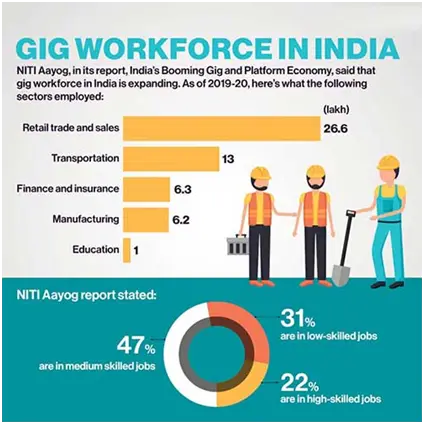
What is the Average Age/Income of Gig Workers in India?
- The median age of Indian gig workers is 27 and their average monthly income is Rs 18,000.
- Of these, about 71 per cent are the sole breadwinners of their families. Additionally, gig workers operate with an average household size of 4.4.
Challenges Faced by Gig Workers:
- While platform companies have created avenues of employment, it has often been marred by low wages, unequal gender participation, and a lack of possibility for upward mobility within an organisation.
- This has triggered protests from workers at companies like Swiggy, Zomato, Ola, Uber, and Urban Company, among others.
- Gig workers are typically hired by companies on a contractual basis and are not considered their employees.
- As a result, they do not receive some of the benefits that an on-roll employee of the company may have.
- This means they often do not receive benefits like paid sick and casual leaves, travel and housing allowances, and provident fund savings, among other things.
What Needs to be Done in Order to Improve the Living Standards of these Gig Workers?
Fiscal Incentives:
- NITI Aayog in its report "India’s Booming Gig and Platform Economy" has suggested that fiscal incentives such as tax-breaks or startup grants may be provided for businesses that offer livelihood opportunities where women constitute a substantial portion of their workers.
Retirement Benefits:
- The report also recommended firms adopt policies that offer old age or retirement plans and benefits, and other insurance cover for contingencies such as the Covid-19 Pandemic.
- Such plans and policies may be envisaged under the Code on Social Security, 2020.
- Businesses should consider providing income support to workers as it would be a “critical step in providing assured minimum earnings and social security from income loss in the wake of uncertainty or irregularity in work.”
- It also suggested offering paid sick leave to workers apart from insurance cover.
The Rajasthan Platform-Based Gig Workers (Registration and Welfare) Act 2023:
- Recently, the Rajasthan State Assembly passed the Rajasthan Platform-Based Gig Workers (Registration and Welfare) Act 2023.
- Under the Act, a board will be established to ensure gig workers’ registration and welfare, addressing their vulnerabilities and providing a platform for collective bargaining and negotiations.
- The board can serve as an independent grievance redress mechanism.
- The Act also has a provision of establishing a social security fund funded through a fee on every transaction.
Key Features of the Draft Bill:
- Termination Clause:
- The draft Bill mandates that the contract between the aggregator and the worker must include a comprehensive list of grounds for terminating the contract.
- Aggregators are prohibited from terminating a worker without providing valid reasons in writing and giving a prior notice period of 14 days.
- Arbitrary terminations, a longstanding grievance among gig workers, are addressed to ensure fair treatment.
- Payment Regulations:
- Aggregators are required to make payments to workers at least every week.
- They must inform workers about any deductions in their payments, specifying the reasons for these deductions.
- Right to Refuse Gigs:
- Under the new draft, gig workers have the right to refuse a specified number of gigs per week with 'reasonable cause', without facing adverse consequences from the aggregator.
- Welfare Fund:
- A welfare fee will be levied either on each transaction between the worker and the company or based on the company's total revenue.
- Contributions from this fee, combined with funds from Union and State governments, will constitute a welfare fund aimed at supporting gig workers.
- Registration and Database:
- All gig workers must be registered, and aggregators are obligated to provide the government with a comprehensive database of these workers.
- Working Conditions:
- Aggregators are required to ensure reasonable and safe working conditions for gig workers, although the draft does not specify the exact criteria for what constitutes 'reasonable' condition
Source: TH
Tax on Ultra High Net Worth Individuals
Why in the News?
- Recently, the Global Tax Evasion Report 2024, commissioned by Brazil’s G-20 presidency, proposes an annual 2% tax on individuals with wealth exceeding $1 billion.
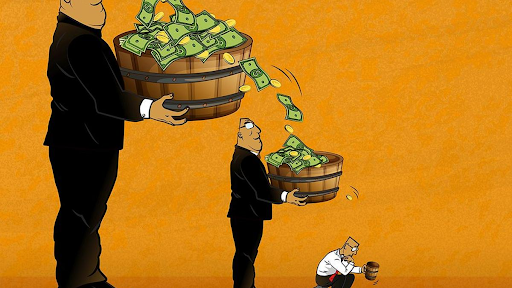
What is a Wealth Tax?
- Meaning: A wealth tax assesses the market value of assets owned by a taxpayer. In India, it was governed by the Wealth Tax Act, 1957, but abolished from April 1, 2016.
Pros and Cons of a Wealth Tax:
- Proponents:
- Equity: Seen as fairer than income tax alone, particularly in societies with significant wealth disparity.
- Fairness: Considers taxpayers’ overall economic status and their ability to pay taxes.
- Critics:
- Economic Growth: Critics argue it discourages wealth accumulation, a driver of economic growth.
- Challenges: Administration and valuation disputes pose challenges, potentially leading to tax evasion.
Analysing the Proposal to Tax Ultra High Net Worth Individuals:
- Recommendation:
- Individuals with wealth exceeding $1 billion should pay a minimum 2% annual tax on their total assets, including equity shares.
- Rationale for Such a Tax:
- Surge in Wealth Concentration: Since the mid-1980s, the wealth of the top 0.0001% households has increased more than fourfold.
- Global Wealth Share: Initially owning 3% of world GDP in wealth, their share rose significantly to 13% by 2024.
- Ineffectiveness of Current Tax Systems: Current tax systems globally inadequately tax the wealthiest individuals, with effective tax rates typically ranging from 0% to 0.5% of their wealth.
- Taxation Discrepancy: Ultra-high-net-worth individuals consequently pay proportionately less tax relative to their income.
- Implications:
- Revenue Loss: Governments suffer significant tax revenue losses due to under-taxation of the wealthiest.
- Economic Disparity: Contributes to concentrating the benefits of globalisation among a small segment of the population.
- Social Sustainability: Undermines the broader social sustainability of economic globalisation efforts.
- Significance:
- Progressive taxation supports social cohesion and governmental trust for collective welfare.
- Increased tax revenues are essential for climate crisis mitigation efforts.
- Impact:
- Finance Ministers of the G-20 will discuss the proposal in Rio de Janeiro, aiming to address global inequality by ensuring adequate taxation of billionaires.
- Supporters and Opposers:
- Supporters: Brazil, France, Spain, Colombia, Belgium, the African Union, and South Africa endorse the idea.
- Opposers: U.S. Treasury Secretary Janet Yellen opposes a global wealth levy.
Relevance of the Proposal for India:
- Income and Wealth Disparity: According to the study ‘Income and Wealth Inequality in India,’ from 2014 to 2023, there has been a sharp rise in wealth concentration among the top 1% income and wealth holders, reaching historical highs of 22.6% and 40.1% respectively.
- Global Comparison: India's top 1% income share ranks among the highest globally, highlighting significant wealth disparities within the country.
- Proposal Impact: Implementing a ‘super tax’ on the wealthiest individuals could effectively mitigate growing inequality and generate substantial fiscal resources for the government.
- Revenue Potential: For example, a modest 2% tax on the total net worth of India's 162 wealthiest families could potentially yield revenue equivalent to 0.5% of the nation's GDP.
- Social and Economic Goals: Such a measure aims not only to redistribute wealth more equitably but also to bolster economic stability and support social welfare initiatives.
Source: TH
Resolution of the Pending Issues
Why in the News?
- Recently, in a significant development aimed at resolving long standing issues stemming from the Andhra Pradesh Reorganisation Act 2014, the Chief Ministers of Telangana and Andhra Pradesh have agreed to establish two committees.
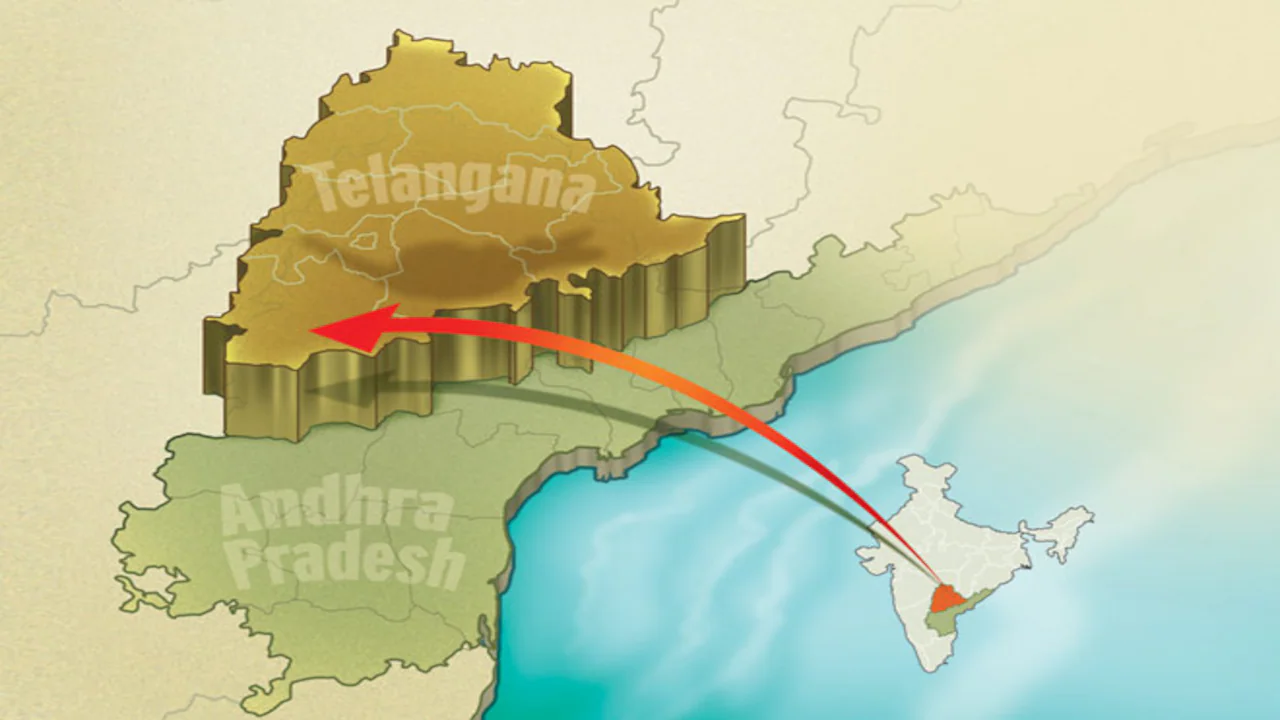
Issues Pending Between Telangana and Andhra Pradesh:
- Background:
- Following the bifurcation of Andhra Pradesh in 2014, the division of assets and liabilities between Telangana and Andhra Pradesh remains unresolved.
- Both states interpret provisions of the Andhra Pradesh Reorganisation Act 2014 differently.
- Assets for Division:
- 91 institutions under Schedule IX
- 142 institutions under Schedule X
- Additional 12 institutions outside the Act’s purview
- Total fixed asset value of ₹1.42 lakh crore
- Key Contention:
- Dispute over institutions like RTC headquarters and Deccan Infrastructure and Landholdings Limited (DIL), which hold substantial land parcels.
- Andhra Pradesh’s Claims:
- Advocates for implementing recommendations of the Sheela Bhide committee on division of 89 Schedule IX institutions.
- Accuses Telangana of selective acceptance causing delays.
- Telangana’s Stand:
- Opposes Sheela Bhide committee recommendations as unfavourable.
- Proposes division based on population, especially for assets located outside the United state.
- Role of the Centre:
- Empowered to intervene under the Act but efforts by dispute resolution committees, chaired by the Union Home Secretary, have not resolved issues post-bifurcation.
How will the Issue be Handled by the Two Committees?
- Ministers’ Committee:
- Composed of ministers from Telangana and Andhra Pradesh.
- Tasked with developing a plan to resolve contentious issues, including assets and liabilities under Schedule IX, X, and others.
- Will address issues escalated from the officials’ committee.
- Officials’ Committee:
- Consists of administrative representatives from both states.
- Initially addresses issues that can be resolved at the bureaucratic level.
- Issues unresolved at this level will be forwarded to the ministers’ committee.
- Chief Ministers’ Intervention:
- Remaining unresolved issues will be escalated to the Chief Ministers of Telangana and Andhra Pradesh for final resolution
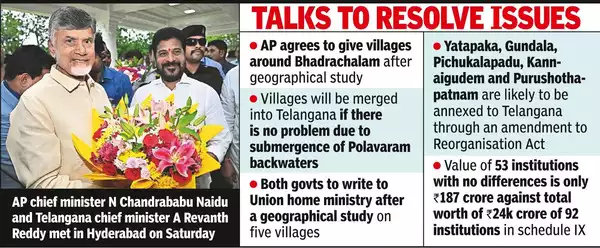
Source: TH
China’s Ambitions for Pan-Asian Rail Network
Why in the news ?
- China has expressed interest in collaborating with Malaysia to explore connecting the East Coast Rail Link (ECRL) with railway networks in Laos and Thailand.
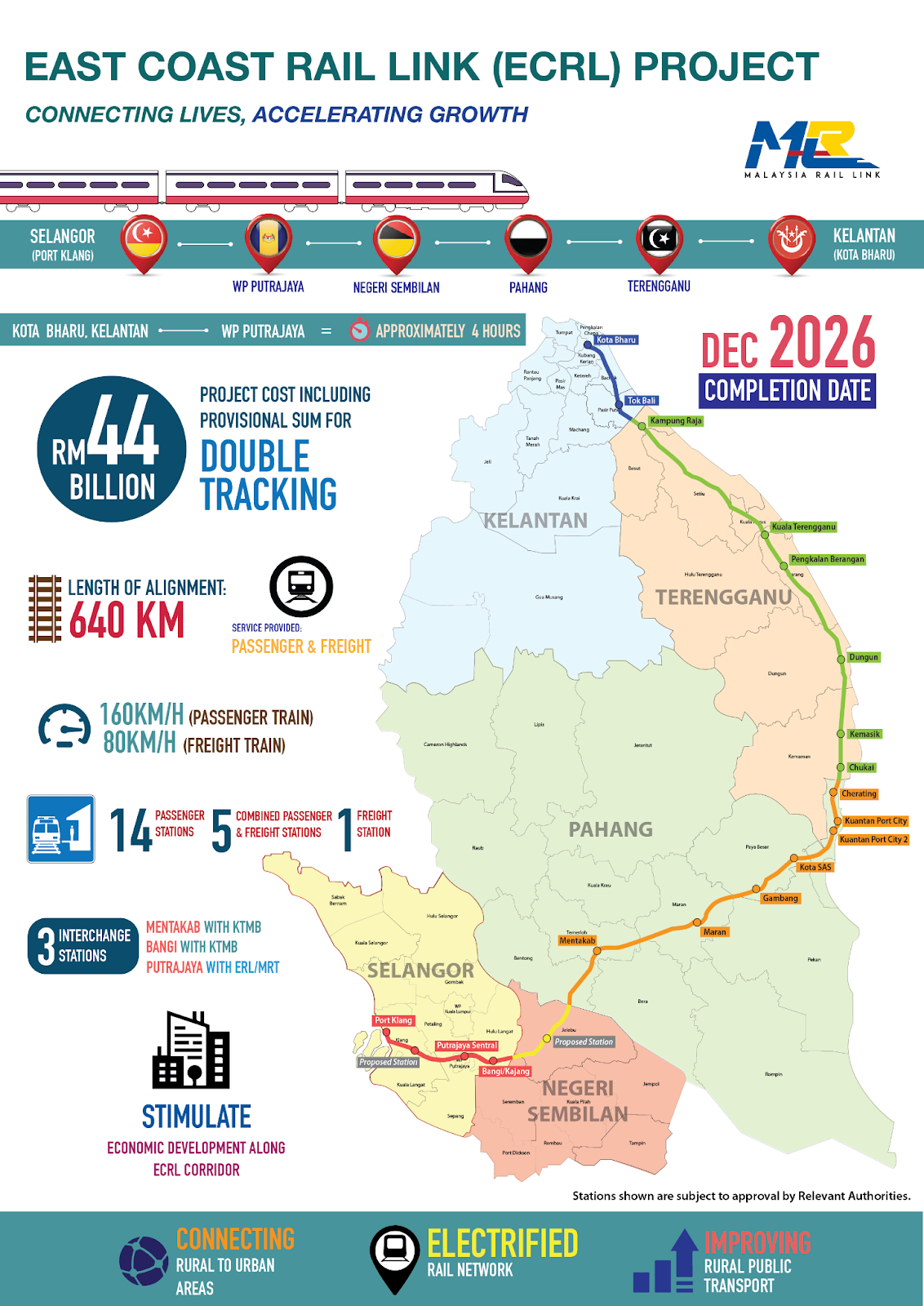
About the ECRL Project :
- East Coast Rail Link (ECRL):
- A 665-km railway project in Malaysia.
- It aims to connect Kota Bharu on the Kelantan River in the northeast to Port Klang on the Strait of Malacca in the west.
- Significant economic cooperation project between China and Malaysia.
- Part of China’s Belt and Road Initiative (BRI).
- Enhances connectivity and upgrades public transportation along Malaysia’s rail network.
- Initially launched in 2017 but faced funding and political challenges, leading to delays until a renegotiated deal in 2020.
- Expected completion by 2027.
China’s Pan-Asian Rail Network Ambitions:
- Comprehensive Rail Network:
- China plans extensive rail networks across Southeast Asia under the BRI.
- Includes western, central, and eastern lines linking China with Myanmar, Laos, Thailand, Vietnam, Cambodia, and Malaysia.
- Aims to boost regional connectivity and strengthen economic ties.
- Challenges include differences in rail track standards and financial viability.
- Current Status:
- Laos-China section operational since 2021, linking Kunming to Laos.
- Projects in Thailand facing delays and scrutiny over costs and terms of Chinese involvement.
Implications:
- Regional Influence:
- China asserts significant influence in Southeast Asia due to geographic proximity and economic ties.
- ECRL and broader rail network projects showcase China’s regional ambitions and infrastructure investments.
- BRI and Geopolitical Dynamics:
- BRI viewed it as a strategy to extend Chinese influence globally.
- Concerns over debt-trap diplomacy and geopolitical tensions with other regional powers.
Impact on India’s Interests:
- BRI Concerns:
- India views BRI as potentially increasing China’s influence in its neighbourhood.
- Concerns include debt dependency among neighbouring countries and strategic implications such as CPEC affecting India’s borders.
Way Forward for India:
- Utilising Soft Power:
- India can leverage its cultural, religious, and civilizational ties to counterbalance Chinese influence.
- Strengthening relationships with ASEAN countries and promoting initiatives like the Quad for regional stability.
- Balanced Engagement:
- India advocates maintaining constructive relations with China while upholding firm positions on issues like the BRI and border disputes.
- Continued engagement with regional partners like Russia to enhance Eurasian cooperation.
- Act Far East Policy:
- India should expedite its Act Far East policy to strengthen ties with Southeast Asia and counterbalance Chinese presence effectively.
Source: IE
CAR-T Cell Therapy
Why in the news?
- CAR-T cell therapy’s risk of causing secondary cancer is small.
- Secondary cancer, also known as metastatic cancer or secondary malignancy, refers to cancer that has spread from its original site to other parts of the body.
- It can also describe a new, distinct cancer that arises from treatment for a previous cancer.
About the Chimeric Antigen Receptor (CAR)-T Cell Therapy:

- CAR-T (chimeric antigen receptor T-cell) therapy is an advanced treatment that reprogrammes a patient’s immune cells to target and fight cancer.
- Initially used for patients with no other options, CAR-T therapy is now approved as a second-line treatment for certain blood cancers, such as lymphoma and multiple myeloma.
- Scientists are also exploring its potential for treating solid tumours, brain cancers, autoimmune diseases, ageing, HIV, and other conditions.
How CAR-T Cell Therapy Cause Secondary Cancer:
- CAR-T cell therapy involves extracting T-cells (a type of white blood cell crucial to the immune system) from a patient and modifying them in a lab to recognise better and attack cancer cells.
- These re-engineered T-cells are called CAR-T cells. They are multiplied and infused into the patient.
- Creating CAR-T cells involves inserting the gene for a chimeric antigen receptor (CAR) into T-cells using engineered retroviruses.
- Although these retroviruses are modified to be safe, there is a risk that the new genetic material could disrupt important genes. This phenomenon is called “insertional mutagenesis”.
- Insertional mutagenesis can potentially lead to cancer.
What are the concerns With CAR-T Cell Therapy ?
- Cytokine Release Syndrome (CRS):
- CRS is an inflammatory response that may occur post CAR-T cell therapy.
- Severe cases can lead to organ failure and potentially death.
- Neurotoxicity:
- A spectrum of side effects affecting the nervous system.
- Ranges from mild symptoms like headache and confusion to severe outcomes such as seizures and coma.
- Low Blood Cell Counts:
- CAR-T therapy can result in decreased counts of red blood cells, white blood cells, and platelets.
- This may lead to increased risk of bleeding and infections.
- Infection Risk:
- The therapy can weaken the immune system, making patients more vulnerable to infections.
- Strict monitoring and preventive measures are crucial to manage this risk effectively.
- Potential for Off-Target Effects:
- CAR-T cells may mistakenly target and attack healthy tissues alongside cancer cells.
- This unintended effect requires careful consideration and management to minimise adverse outcomes.
Source: (TH)
ASUSE
Why in the news ?
- Recently, ASUSE was conducted by the National Sample Survey Office, Ministry of Statistics and Programme Implementation.
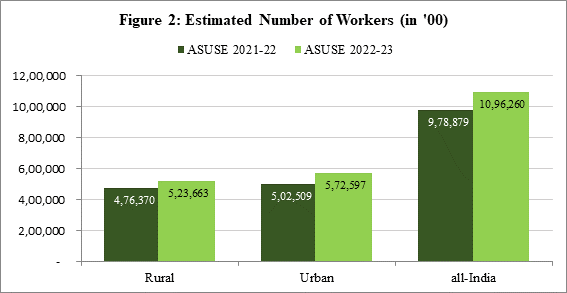
Scope:
- ASUSE covers unincorporated non-agricultural establishments.
- Includes proprietorships, partnerships (excluding LLPs), Self-Help Groups (SHGs), cooperatives, societies/trusts, etc.
About Unincorporated Enterprises:
- These are producer units not incorporated as separate legal entities.
- Assets used belong to owners, not the enterprises.
- Enterprises cannot engage in transactions or incur liabilities independently.
Key Highlights:
- Establishments Growth: Grew by 5.88% from 2021-22 to reach 6.50 crore, with 55% in rural areas.
- Top States: Uttar Pradesh, West Bengal, and Maharashtra have the highest number of establishments.
- Gross Value Added (GVA): Increased by 9.83% from 2021-22.
- Women Entrepreneurs: Led 54% of proprietary establishments in the Manufacturing sector.
- Digitization: Rapid digitization with a 7.2% increase in internet usage for entrepreneurial purposes.
- Credit Availability: Improved, with outstanding loan per establishment rising to Rs. 50,138 in 2022-23.
Significance of Unincorporated Enterprises:
- Contribution to Economy:
- GDP and Employment: Unincorporated enterprises are pivotal contributors to GDP and employment generation, with approximately 11 crore workers employed in 2022-23.
- Supply Chain Integral: They play a crucial role in the supply chain by acting as suppliers and service providers to the incorporated sector.
Challenges Faced by Unincorporated Enterprises:
- Financial Constraints:
- Access to Formal Credit: Many face challenges in accessing formal credit, limiting their growth potential.
- Registration Issues: Lack of formal registration can hinder their ability to participate fully in the economy.
- Regulatory Vulnerabilities:
- Minimal Oversight: Limited regulatory oversight makes them vulnerable to economic shocks and sudden policy changes, affecting their stability and growth prospects.
Source: MOSPI
Mount Etna
Why in the news ?
- Recently, Italy's Mount Etna and the smaller Stromboli volcano have been active, ejecting hot ash and lava, prompting heightened alert levels on the Mediterranean island of Sicily.
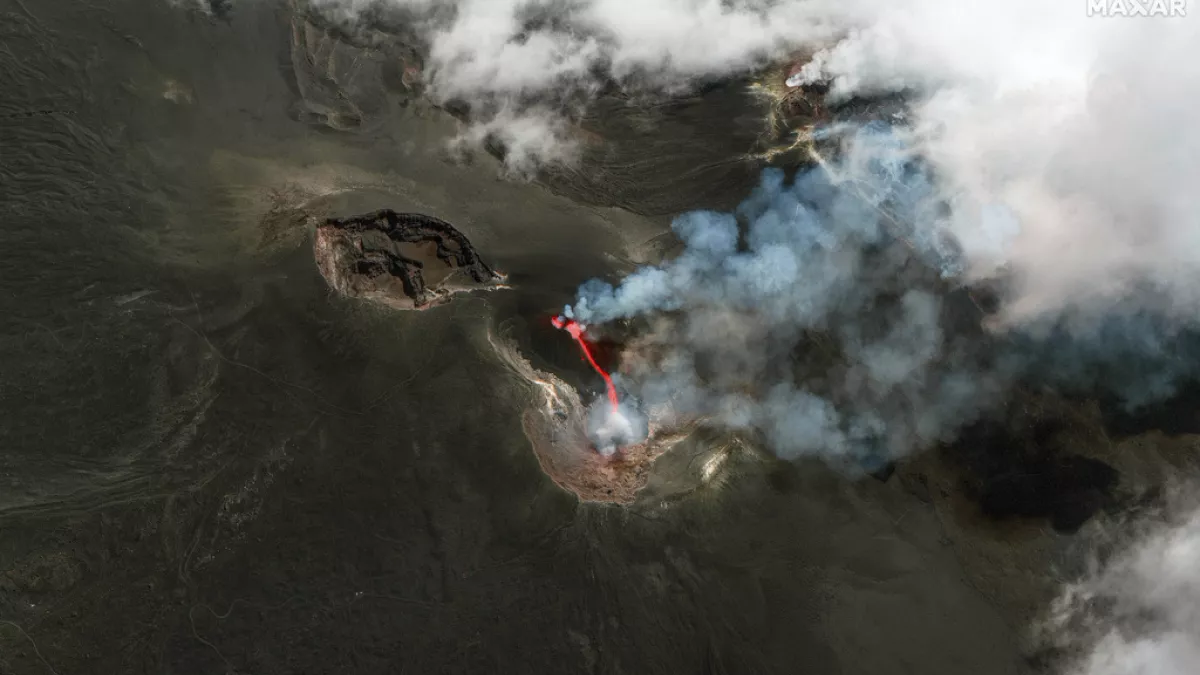
About the Mount Etna:
- Europe’s Most Active Volcano: Mount Etna is Europe’s most active volcano and one of the largest in the world.
- Historical Activity: Recorded volcanic activity at Mount Etna dates back to 1500 B.C.
- Location: It is situated on the eastern coast of Sicily, Italy.
- Geographical Features: Mount Etna stands at about 3,326 metres (10,912 feet) high, making it the highest peak in Italy south of the Alps. It is also the highest Mediterranean island mountain.
What are Volcanoes ?
- Definition: Volcanoes are openings or vents on the Earth’s surface where lava, tephra (small rocks), and steam erupt.
- Formation: They can form on land and in the ocean, often due to the movement and collision of tectonic plates.
Types of Volcanoes:
- Cinder Cones:
- Description: Steep conical hills made of loose pyroclastic fragments like volcanic ash and scoria.
- Formation: Built around a volcanic vent from explosive eruptions.
- Composite or Stratovolcanoes:
- Description: Steep cones formed by layers of hardened lava and tephra.
- Lava Type: High viscosity lava that solidifies quickly, limiting spread.
- Example: Mount Etna in Italy.
- Shield Volcanoes:
- Description: Broad, gently sloping volcanoes formed by low-viscosity lava that spreads over large distances.
- Formation: Repeated eruptions build up thin layers of lava.
- Example: Mauna Loa in Hawaii.
- Lava Domes:
- Description: Circular mounds formed by slow extrusion of viscous lava.
- Characteristics: Typically found in the crater of larger volcanoes.
- Example: Novarupta Dome in Alaska.
Eruption Mechanism:
- Cause: Volcanoes erupt due to pressure from magma beneath the Earth’s surface forcing its way through cracks and vents.
- Process: This release of pressure results in the expulsion of lava, ash, and gases.
- Intensity: Eruptions can be explosive when pressure exceeds the crust's ability to contain it.
Significant Regions:
- Ring of Fire: A highly volcanic and seismically active region encircling the Pacific Ocean.
- Location: Includes countries like Japan, Indonesia, New Zealand, and the western coasts of North and South America.
- Activity: Approximately 90% of global earthquakes occur within the Ring of Fire due to tectonic plate interactions.
Prediction of Volcanic Eruptions:
- Seismographic Data:
- Method: Monitoring earthquakes and tremors near volcanoes.
- Significance: Sudden increases in seismic activity can indicate magma movement and potential eruption.
- Ground Deformation:
- Method: Using GPS and satellite radar to measure changes in the ground’s shape.
- Significance: Swelling or bulging of the volcano indicates magma movement beneath the surface.
- Gas Emissions:
- Method: Monitoring volcanic gas emissions, including sulfur dioxide and carbon dioxide.
- Significance: Changes in gas composition and volume can signal increasing volcanic activity.
- Gravity and Magnetic Field Changes:
- Method: Tracking alterations in gravity and magnetic fields near volcanoes.
- Significance: Magma movements can cause subtle changes in these fields, which are detected by specialised instruments.
Source: RW
Indian PM on a Two-Day Visit to Moscow
Why in the News?
- Recently, the Indian Prime Minister is embarking on a crucial two-day visit to Moscow for the annual India-Russia summit, a tradition dating back to 2000.

What Makes the Indian PM’s Visit to Russia Special this Time?
- First visit since Russia's invasion of Ukraine:
- This marks the first bilateral meeting between the Indian PM and Russian President Vladimir Putin since Russia's invasion of Ukraine in February 2022.
- The two leaders have met a total of 16 times since 2014.
- The Indian PM's last visit to Russia was for the Eastern Economic Forum meeting in Vladivostok in September 2019.
- The Russian President's last visit to India was in December 2021 for the annual bilateral summit.
- Breaking with tradition:
- By choosing Russia for his first bilateral visit after assuming office, the Indian PM departs from the tradition of new Indian PMs typically visiting neighbouring countries first.
- For instance, in June 2014, he visited Bhutan, and in June 2019, he visited Maldives and Sri Lanka.
- Last month, he travelled to Italy for a multilateral meeting of G7 leaders, marking another recent international engagement.
Significance of the Indian PM’s Visit to Russia:
- Foreign policy priority:
- The relationship between Russia and India spans seven decades, rooted in the generosity and friendship of the USSR era. While defence remains the cornerstone of their strategic partnership, collaboration in space and nuclear sectors also holds significant importance.
- Global context:
- The bilateral meeting coincides with a gathering of leaders from 32 NATO nations in Washington DC, marking 75 years of the alliance, highlighting the global significance of India-Russia relations.
- Russia’s relations with China:
- As India diversifies its global relationships, its ties with Russia have faced challenges in some areas. Meanwhile, Russia's deepening ties with China have provided diplomatic and economic support amid Western sanctions linked to the Ukraine conflict. India remains vigilant in ensuring that military technologies shared with it by Russia are not transferred to other countries, including China.
Key Areas of Engagement Between India and Russia:
- Defence:
- During the Cold War era, the USSR was India's primary supplier of defence equipment. Currently, an estimated 60-70% of India’s defence equipment is of Russian and Soviet origin.
- Defence cooperation has progressed from a buyer-seller relationship to include joint research and development, co-development, and joint production.
- India and Russia have agreements covering the supply of S-400 Triumf mobile surface-to-air missile systems, MiG-29 fighter aircraft, and Kamov helicopters.
- The licensed production of T-90 tanks, Su-30MKI fighters, AK-203 assault rifles, and BrahMos supersonic cruise missiles.
- The INS Vikramaditya, one of India's two aircraft carriers, originated as the Soviet and Russian warship Admiral Gorshkov.
- Oil trade:
- Since the onset of the conflict in Ukraine, India has increased its purchase of Russian oil at discounted rates to mitigate the inflationary impact of rising crude prices.
- Despite international criticism, India’s External Affairs Minister has affirmed the country’s commitment to continue buying Russian oil in the interest of Indian consumers.
- Trade:
- Bilateral trade volumes between India and Russia have surpassed expectations, reaching an all-time high of $65.70 billion in FY 2023-24, surpassing the earlier target of $30 billion by 2025.
Challenges for India in Maintaining its Ties with Russia:
- Trade imbalance:
- India's imports from Russia total $61.44 billion, dominated by Russian oil, petroleum products, fertilisers, mineral resources, precious stones, metals, and vegetable oils, resulting in a significant trade deficit.
- Diplomatic balancing act:
- India has refrained from explicitly condemning Russia's invasion but has expressed concerns over threats of nuclear conflict issued by Russian leaders.
- India has abstained from voting against Russia in several UN Security Council resolutions.
- Maintaining relations with Western nations:
- India's stance during the Russia-Ukraine conflict has strained its relations with Western allies, evidenced by a series of recent meetings with them preceding the Indian PM’s visit to Russia.
- Mediator role:
- There is a perception that India is positioning itself as a neutral mediator between Russia and Ukraine, seeking to facilitate dialogue.
- Safety of Indians in Russia:
- Some Indians in Russia are reported to have been misled into participating in the conflict in Ukraine.
- India has called for their safe return, and this issue is expected to be addressed during the Indian PM’s visit.
Way Ahead for India:
- India’s primary focus remains on sustaining its defence relationship with Russia. Addressing the growing Moscow-Beijing alliance, which poses challenges to Indian strategic interests. The Indian PM’s visit aims to:
- Strengthen the longstanding ties between India and Russia.
- Ensure that the burgeoning Moscow-Beijing relationship does not negatively impact India's bilateral relations with Russia.
Source: TOI
Share the article
Get Latest Updates on Offers, Event dates, and free Mentorship sessions.

Get in touch with our Expert Academic Counsellors 👋
FAQs
UPSC Daily Current Affairs focuses on learning current events on a daily basis. An aspirant needs to study regular and updated information about current events, news, and relevant topics that are important for UPSC aspirants. It covers national and international affairs, government policies, socio-economic issues, science and technology advancements, and more.
UPSC Daily Current Affairs provides aspirants with a concise and comprehensive overview of the latest happenings and developments across various fields. It helps aspirants stay updated with current affairs and provides them with valuable insights and analysis, which are essential for answering questions in the UPSC examinations. It enhances their knowledge, analytical skills, and ability to connect current affairs with the UPSC syllabus.
UPSC Daily Current Affairs covers a wide range of topics, including politics, economics, science and technology, environment, social issues, governance, international relations, and more. It offers news summaries, in-depth analyses, editorials, opinion pieces, and relevant study materials. It also provides practice questions and quizzes to help aspirants test their understanding of current affairs.
Edukemy's UPSC Daily Current Affairs can be accessed through:
- UPSC Daily Current Affairs can be accessed through Current Affairs tab at the top of the Main Page of Edukemy.
- Edukemy Mobile app: The Daily Current Affairs can also be access through Edukemy Mobile App.
- Social media: Follow Edukemy’s official social media accounts or pages that provide UPSC Daily Current Affairs updates, including Facebook, Twitter, or Telegram channels.


